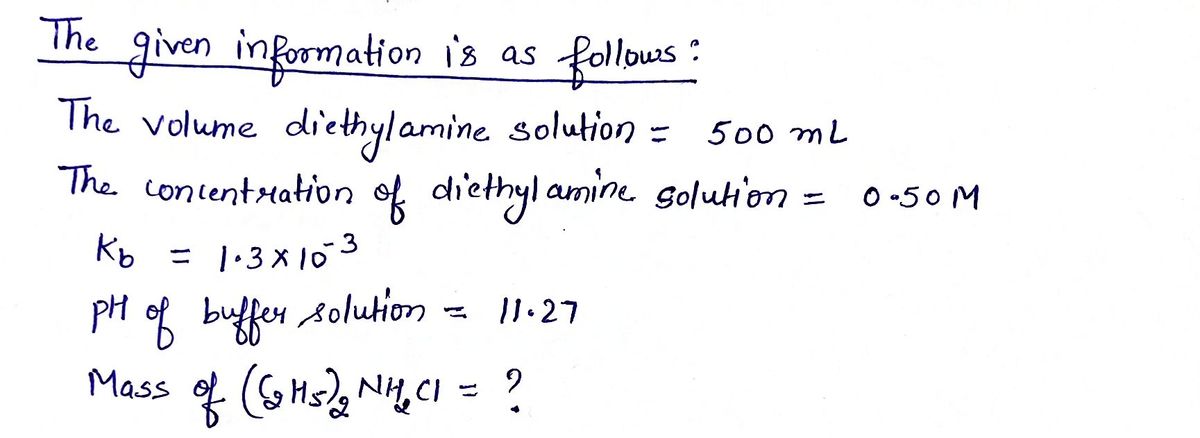ΝΗ A chemistry graduate student is given 500. mL of a 0.50M diethylamine ((C₂H₂)₂NH) solution. Diethylamine is a weak base with K₂=1.3 × 10³. What mass of (C₂H₂)₂NH₂Cl should the student dissolve in the (C₂H5) NH solution to turn it into a buffer with pH = 11.27? You may assume that the volume of the solution doesn't change when the (C₂H₂)₂NH₂Cl is dissolved in it. Be sure your answer has a unit symbol, and round it to 2 significant digits. [] x10 X
ΝΗ A chemistry graduate student is given 500. mL of a 0.50M diethylamine ((C₂H₂)₂NH) solution. Diethylamine is a weak base with K₂=1.3 × 10³. What mass of (C₂H₂)₂NH₂Cl should the student dissolve in the (C₂H5) NH solution to turn it into a buffer with pH = 11.27? You may assume that the volume of the solution doesn't change when the (C₂H₂)₂NH₂Cl is dissolved in it. Be sure your answer has a unit symbol, and round it to 2 significant digits. [] x10 X
Chemistry
10th Edition
ISBN:9781305957404
Author:Steven S. Zumdahl, Susan A. Zumdahl, Donald J. DeCoste
Publisher:Steven S. Zumdahl, Susan A. Zumdahl, Donald J. DeCoste
Chapter1: Chemical Foundations
Section: Chapter Questions
Problem 1RQ: Define and explain the differences between the following terms. a. law and theory b. theory and...
Related questions
Question

Transcribed Image Text:3
A chemistry graduate student is given 500. mL of a 0.50M diethylamine ((C₂H5), NH) solution. Diethylamine is a weak base with K₁= 1.3 × 10¯³.
mass of (C₂H₂)2NH₂Cl should the student dissolve in the (C₂H₂)₂NH solution to turn it into a buffer with pH = 11.27?
b
You may assume that the volume of the solution doesn't change when the (C₂H₂)NH₂Cl is dissolved in it. Be sure your answer has a unit symbol, and
2
round it to 2 significant digits.
x10
X
What
Ś
Expert Solution
Step 1

Step by step
Solved in 3 steps with 3 images

Follow-up Questions
Read through expert solutions to related follow-up questions below.
Follow-up Question

Transcribed Image Text:A chemistry graduate student is given 450. mL of a 1.50M propanoic acid (HC₂HCO₂) solution. Propanoic acid is a weak acid with K=1.3 × 10¯.
mass of NaC₂H₂CO₂ should the student dissolve in the HC₂H5CO₂ solution to turn it into a buffer with pH = 4.72?
2
You may assume that the volume of the solution doesn't change when the NaC₂H-CO₂ is dissolved in it. Be sure your answer has a unit symbol, and round
it to 2 significant digits.
0
x10
X
What
5
Solution
Knowledge Booster
Learn more about
Need a deep-dive on the concept behind this application? Look no further. Learn more about this topic, chemistry and related others by exploring similar questions and additional content below.Recommended textbooks for you

Chemistry
Chemistry
ISBN:
9781305957404
Author:
Steven S. Zumdahl, Susan A. Zumdahl, Donald J. DeCoste
Publisher:
Cengage Learning

Chemistry
Chemistry
ISBN:
9781259911156
Author:
Raymond Chang Dr., Jason Overby Professor
Publisher:
McGraw-Hill Education

Principles of Instrumental Analysis
Chemistry
ISBN:
9781305577213
Author:
Douglas A. Skoog, F. James Holler, Stanley R. Crouch
Publisher:
Cengage Learning

Chemistry
Chemistry
ISBN:
9781305957404
Author:
Steven S. Zumdahl, Susan A. Zumdahl, Donald J. DeCoste
Publisher:
Cengage Learning

Chemistry
Chemistry
ISBN:
9781259911156
Author:
Raymond Chang Dr., Jason Overby Professor
Publisher:
McGraw-Hill Education

Principles of Instrumental Analysis
Chemistry
ISBN:
9781305577213
Author:
Douglas A. Skoog, F. James Holler, Stanley R. Crouch
Publisher:
Cengage Learning

Organic Chemistry
Chemistry
ISBN:
9780078021558
Author:
Janice Gorzynski Smith Dr.
Publisher:
McGraw-Hill Education

Chemistry: Principles and Reactions
Chemistry
ISBN:
9781305079373
Author:
William L. Masterton, Cecile N. Hurley
Publisher:
Cengage Learning

Elementary Principles of Chemical Processes, Bind…
Chemistry
ISBN:
9781118431221
Author:
Richard M. Felder, Ronald W. Rousseau, Lisa G. Bullard
Publisher:
WILEY